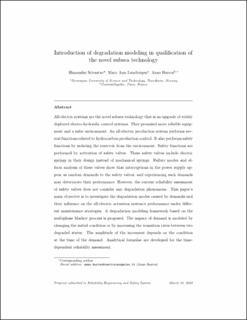| dc.contributor.author | Srivastav, Himanshu | |
| dc.contributor.author | Lundteigen, Mary Ann | |
| dc.contributor.author | Barros, Anne | |
| dc.date.accessioned | 2022-09-27T12:12:12Z | |
| dc.date.available | 2022-09-27T12:12:12Z | |
| dc.date.created | 2021-11-19T12:33:13Z | |
| dc.date.issued | 2021 | |
| dc.identifier.citation | Reliability Engineering & System Safety. 2021, 216 . | en_US |
| dc.identifier.issn | 0951-8320 | |
| dc.identifier.uri | https://hdl.handle.net/11250/3021793 | |
| dc.description.abstract | All-electric systems are the novel subsea technology that is an upgrade of widely deployed electro-hydraulic control systems. They promised more reliable equipment and a safer environment. An all-electric production system performs several functions related to hydrocarbon production control. It also performs safety functions by isolating the reservoir from the environment. Safety functions are performed by activation of safety valves. These safety valves include electric springs in their design instead of mechanical springs. Failure modes and effects analysis of these valves show that interruptions in the power supply appear as random demands to the safety valves, and experiencing such demands may deteriorate their performance. However, the current reliability assessment of safety valves does not consider any degradation phenomena. This paper’s main objective is to investigate the degradation modes caused by demands and their influence on the all-electric actuation system’s performance under different maintenance strategies. A degradation modeling framework based on the multiphase Markov process is proposed. The impact of demand is modeled by changing the initial condition or by increasing the transition rates between two degraded states. The amplitude of the increment depends on the condition at the time of the demand. Analytical formulae are developed for the time-dependent reliability assessment. | en_US |
| dc.language.iso | eng | en_US |
| dc.publisher | Elsevier | en_US |
| dc.rights | Attribution-NonCommercial-NoDerivatives 4.0 Internasjonal | * |
| dc.rights.uri | http://creativecommons.org/licenses/by-nc-nd/4.0/deed.no | * |
| dc.title | Introduction of degradation modeling in qualification of the novel subsea technology | en_US |
| dc.type | Journal article | en_US |
| dc.type | Peer reviewed | en_US |
| dc.description.version | acceptedVersion | en_US |
| dc.rights.holder | This article will not be available until December 2023 due to publisher embargo - This accepted manuscript is made available under the CC-BY-NC-ND 4.0 license | en_US |
| dc.source.pagenumber | 14 | en_US |
| dc.source.volume | 216 | en_US |
| dc.source.journal | Reliability Engineering & System Safety | en_US |
| dc.identifier.doi | 10.1016/j.ress.2021.107956 | |
| dc.identifier.cristin | 1956435 | |
| dc.relation.project | Norges forskningsråd: 237893 | en_US |
| cristin.ispublished | true | |
| cristin.fulltext | postprint | |
| cristin.qualitycode | 2 | |

